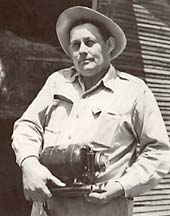The TVA Idea
Blunt and outspoken, travel writer John Gunther had a habit of letting the chips fall where they may. His tough talk may even have won him a place on a Nazi hit list. But when it came to TVA, he purred like a kitten.
“Quite possibly the TVA idea is the greatest single American invention of this century, the biggest contribution the United States has yet made to society in the modern world.”
That’s a bolder statement than we‘re likely to hear even from people who work for TVA. But, as it happens, no one paid John Gunther to say that in his best-selling book “Inside USA,” published in 1947.

The Watts Bar Steam Plant, pictured in John Gunther’s booklet “The Story of TVA.”
Gunther, in fact, was an independent journalist with a cynical streak, and no pushover. A decade earlier he’d ignored death threats from Hitler’s secret police to write his famous Nazi-era exposé “Inside Europe.”
When Gunther spoke of “the modern world,” he knew what he was talking about. It was said that the Chicago-born writer had “crossed more borders and interviewed more statesmen … than any journalist of his time.”
And he was awed by TVA.
Gunther may be best known today as the author of “Death Be Not Proud,” a painful memoir of his teenage son’s death of cancer. He also wrote several novels, but in the ’30s and ’40s, his work set the standard for personal travel writing.
Gunther’s books “Inside Europe” (1936) and “The High Cost of Hitler” (1939) gave many Americans their first glimpse of just how bad things had gotten in Nazi Germany. They say that the SS marked him for death. After that, most of his books were Book-of-the-Month Club bestsellers.
So American readers held their breath when they heard that John Gunther was turning his unblinking gaze on his own country. In the mid-’40s he traveled throughout America, researching his next major book.
By May 1945, when he arrived in the Tennessee Valley, he was so famous that as he interviewed local people for “Inside USA,” local people interviewed him. His comments made the regional newspapers, and all he seemed to want to talk about was TVA.

In “The Story of TVA,” Gunther quoted J.W. Shouse of Hickman County, Tennessee: “We get more for our money out of electricity than anything we spend for it.”
The public corporation was 12 years old, at the end of its dramatic period of massive dam-building, and long past its dreamy utopian beginnings. But John Gunther still thought that the reality of public-private cooperation centering on a shared river valley was just about the best thing he’d ever come across.
“I consider it to be the single most indispensable thing to see in the U.S. It shows the world of tomorrow as against the world of yesterday … I can’t say how much I’ve been impressed by this experiment here—I’ve been inspired. I’ve seen something that should strike deep into the heart of every American.”
His book included an entire chapter on the agency, “Model TVA.” In it he repeatedly quotes Chairman David Lilienthal, whom Gunther admired and befriended, and praised TVA’s efficiency and morale.
His conclusions are poignant: “The future of TVA is of course more TVA’s,” he wrote. “We have talked about the Columbia and the Missouri [Rivers]; an even more pressing case [for development] might be made for the Arkansas … The range of the concept is indeed almost boundless; it knows no barriers except the selfishness of man, and its horizon could be illimitable.”
“Inside USA” was not only an American bestseller when it came out in the spring of 1947, but a worldwide sensation translated into many languages. The great novelist Sinclair Lewis called it “the richest treasure house of facts about America that has ever been published, and probably the most spirited and interesting.” Somehow it even spawned a Broadway play.
Gunther’s judgment of the importance of TVA is evident in the fact that the only published excerpt from his most famous “Inside” book was an illustrated booklet called “The Story of TVA.” From his office in New York, Gunther continued to take a particular interest in the agency. At times he was a fierce advocate for it during the postwar years, when suspicious politicians were arguing that the New Deal holdover should be dismantled.
Although he was occupied with other projects, including a travel book about life behind the Iron Curtain and his wrenching memoir about his son, Gunther kept rooting for TVA. In 1951 he wrote to TVA Chairman Gordon Clapp, offering to help arrange visits to the agency by UN delegates. His booklet on TVA was being published in new editions as late as 1953, six years after the publication of “Inside USA.”
Some 30 years after Gunther’s death, “Inside USA” has not been forgotten. There was a good deal of retrospective discussion of the book at its 50th anniversary in 1997; the renewed interest led to a new edition, published internationally by New Press. Included, of course, is the chapter about TVA—still inspiring in the 21st century, as Gunther, the hard-nosed visionary, would have wished it to be.
After all, what impressed him most about TVA was its bottom line. TVA, he wrote, “proves that the idea of unified development works, that national resources can be developed with politics excluded and without prejudice to private enterprise.
“It can be done. What more should one legitimately ask?”
